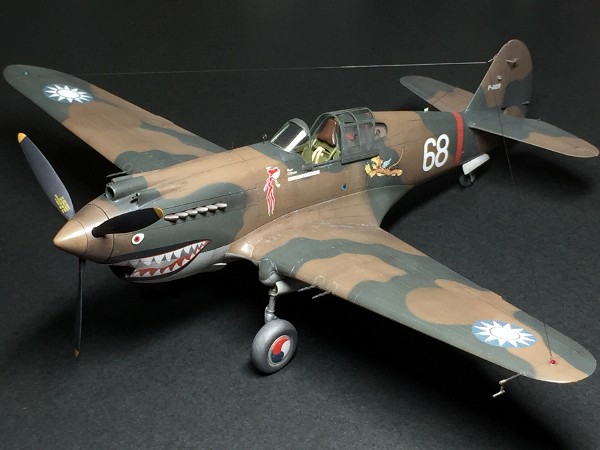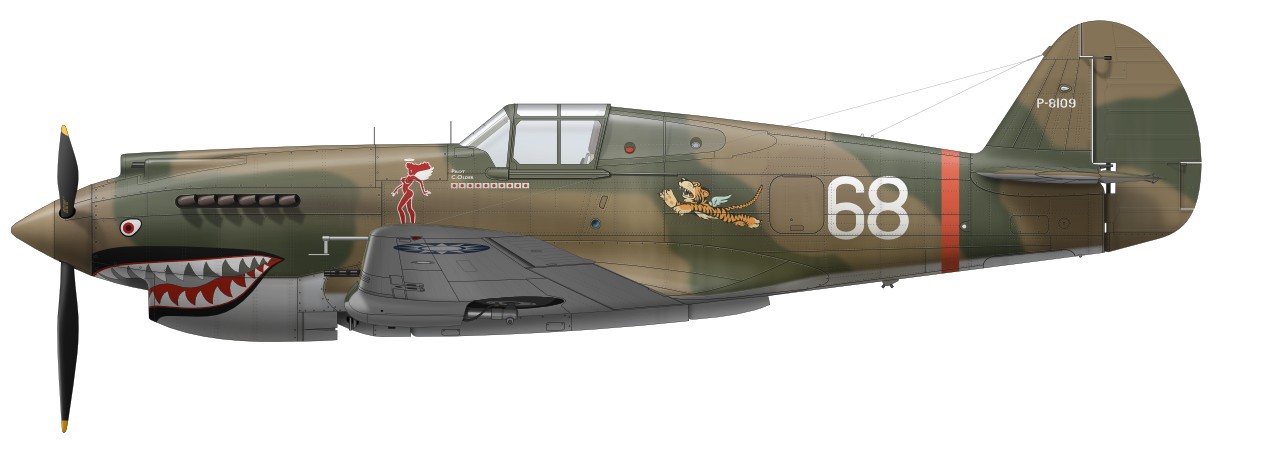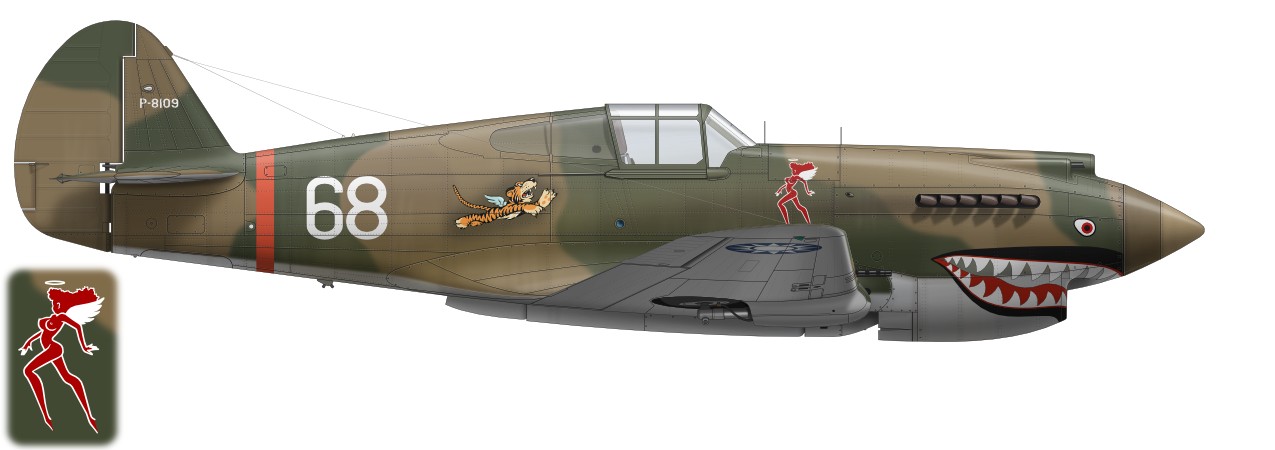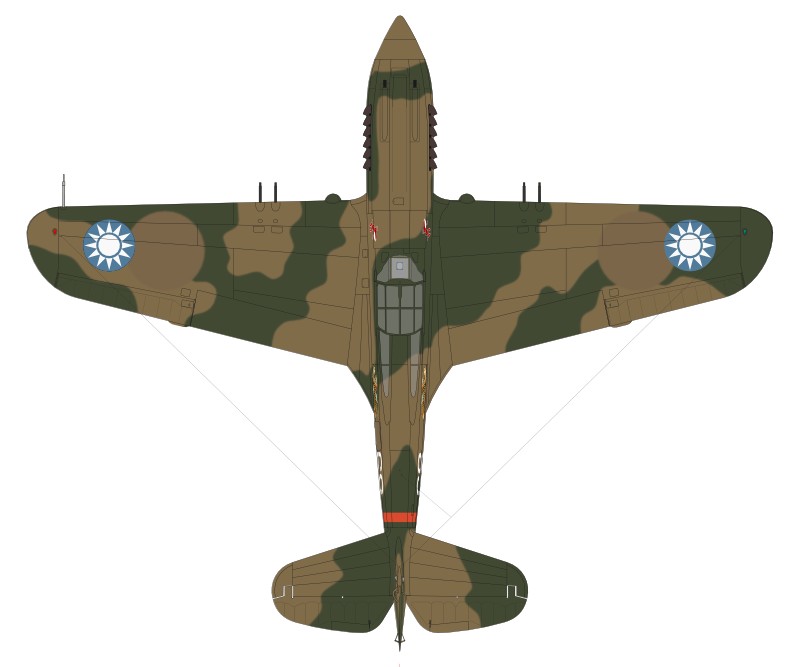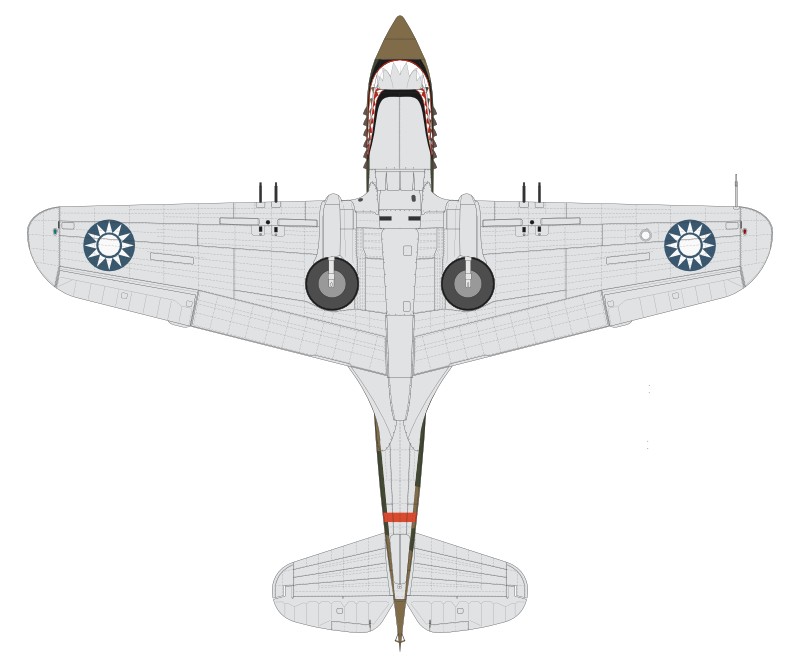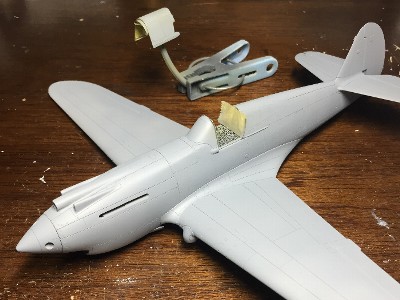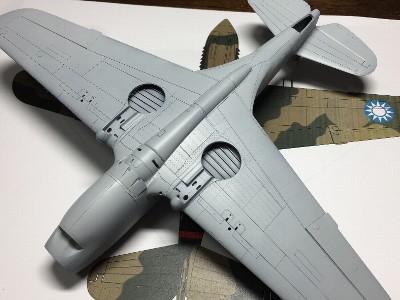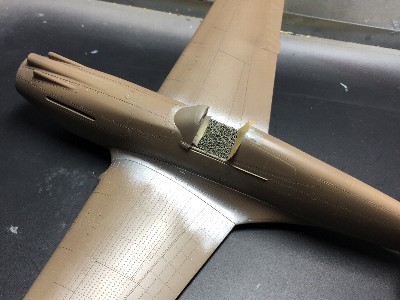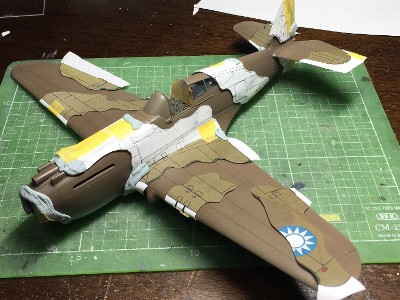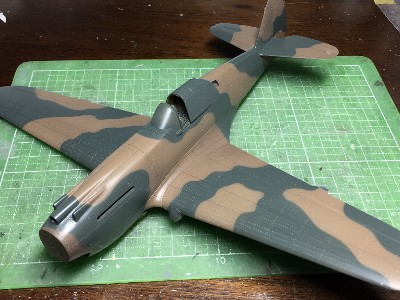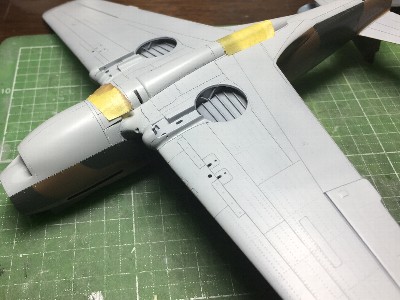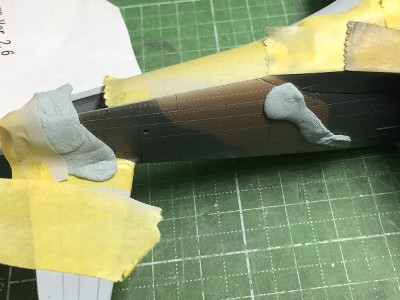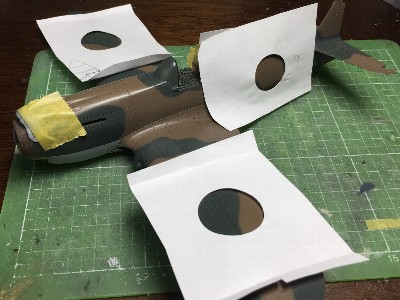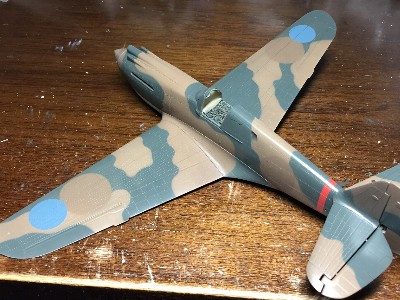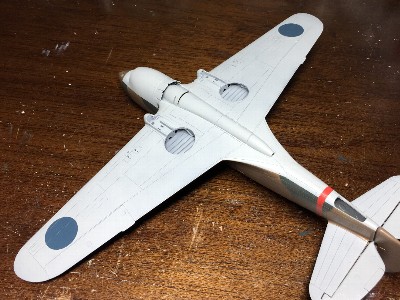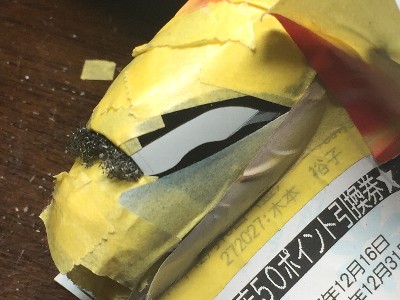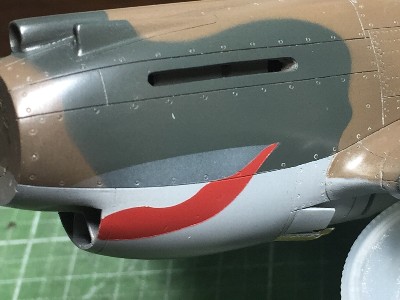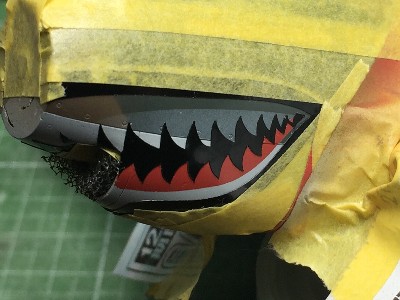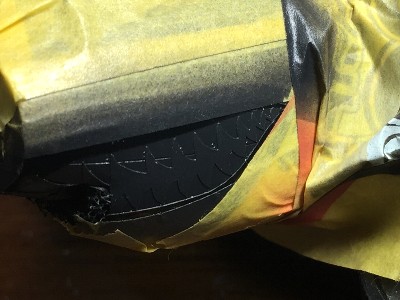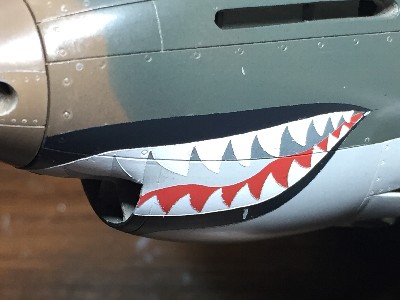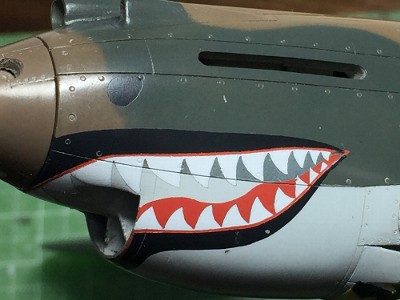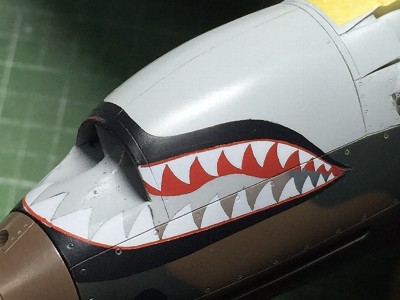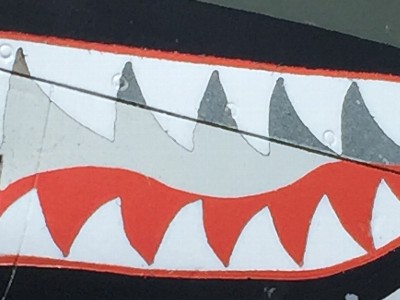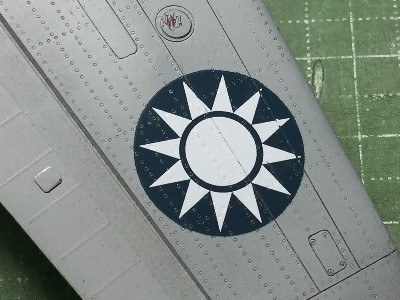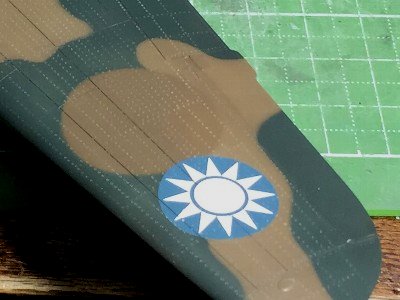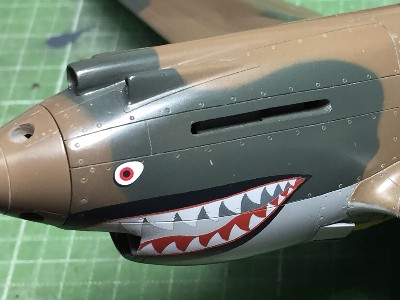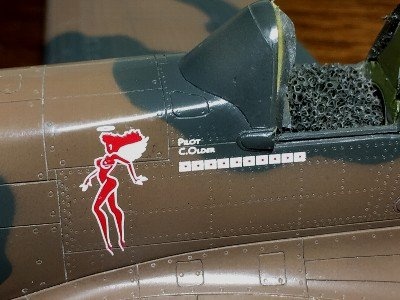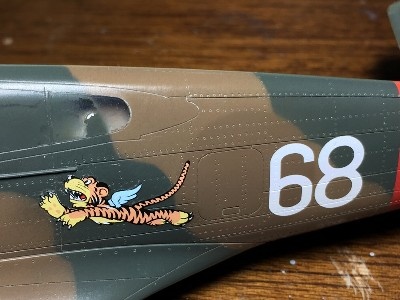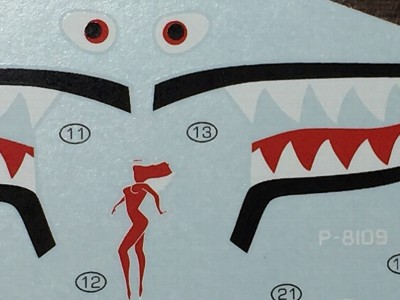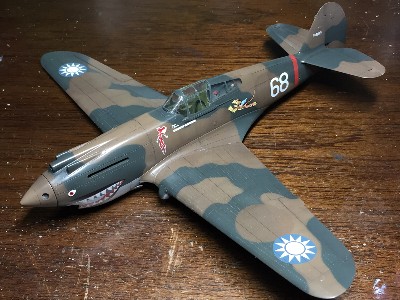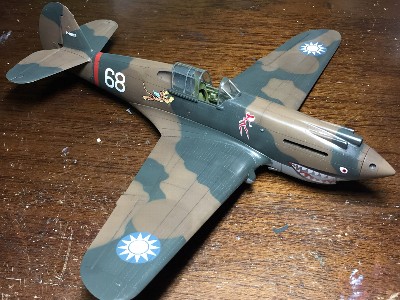Data download
Here are data of the shark teeth masking and other dry decals.
Data file download
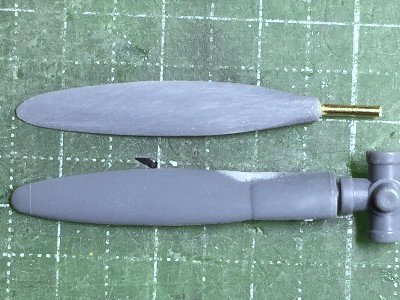
The propeller blade was from Tamiya P-47. The cuff was sanded off.
|
|
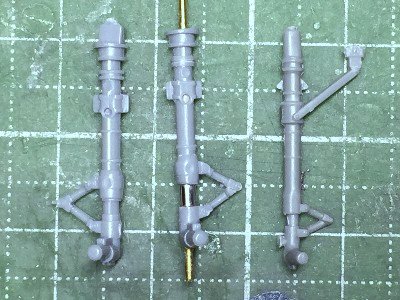
The gear was from Hasegawa. The left is Hasegawa. The right is Airfix. The oleo was brass pipe plated with solder.
|
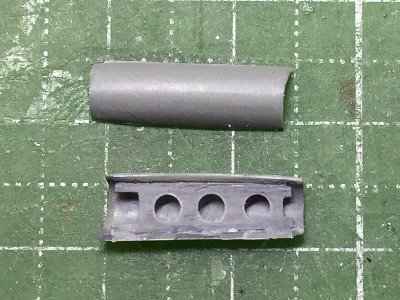
The gear cover was from the kit. Inner side details were added.
|
|
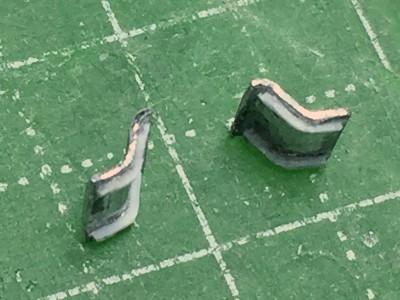
The small cover was made of aluminum sheet with plastic strip.
|
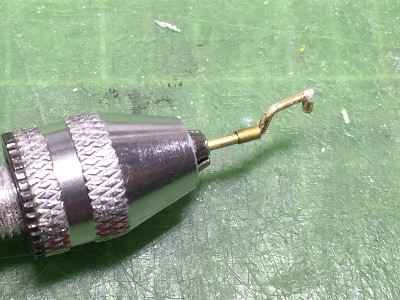
The tail gear shaft was brass rod. CA glue and plastic powder was added on the corner.
|
|
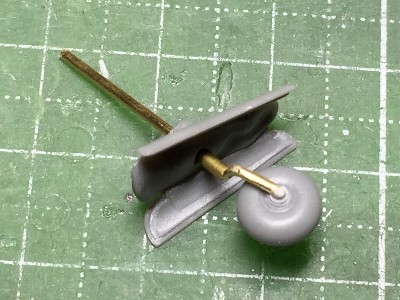
The cover and tire were from the kit.
|
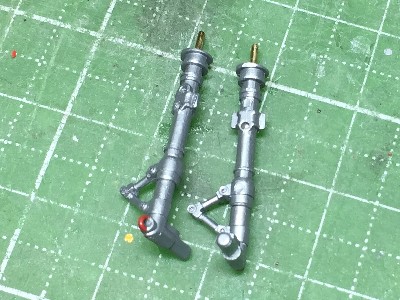
Hasegawa's gear leg was painted. The red ring was a fiction.
|
|
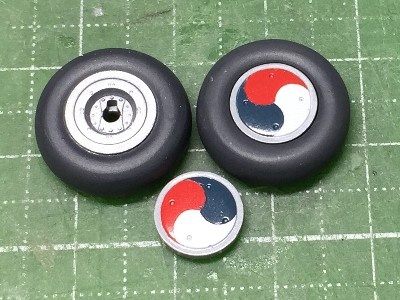
The tire and wheel cap were from Hasegawa as well. The left and right caps are mirror image.
|
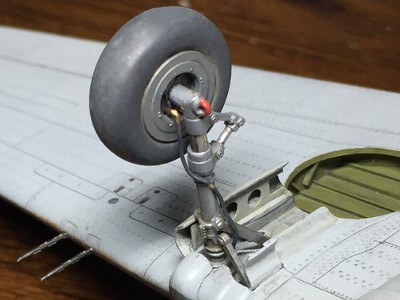
The gear was glued on the wing.
|
|
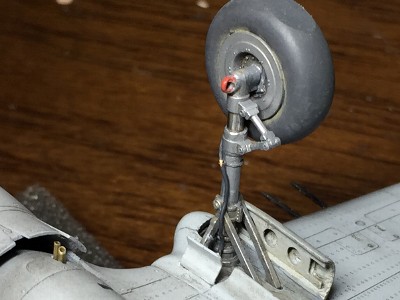
The small linkages were from hasegawa. The drain was added with brass pipe.
|
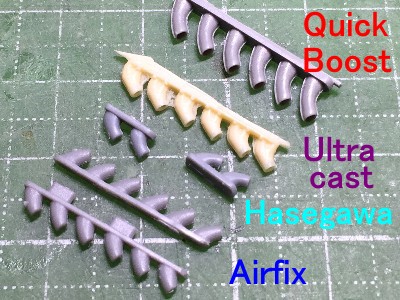
I collected after market parts. But the kit parts is the best.
|
|
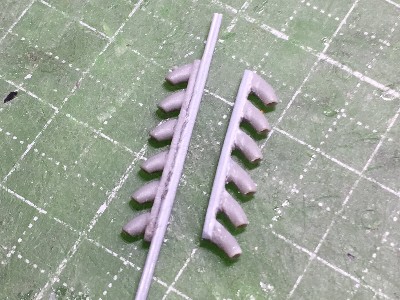
Plastic sheet was glued on the base of the kit exhaust (left). Then the base was cut (right).
|
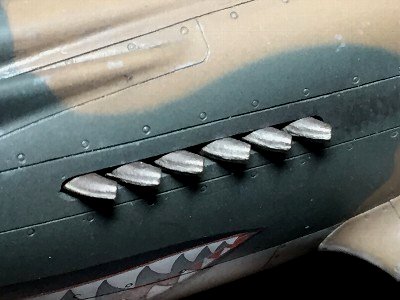
The weld line was added with extended sprue.
|
|
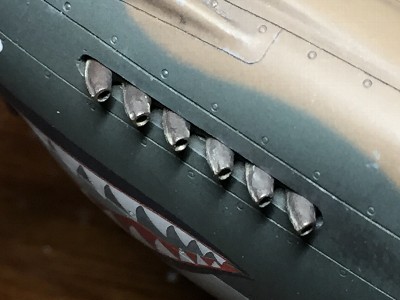
|
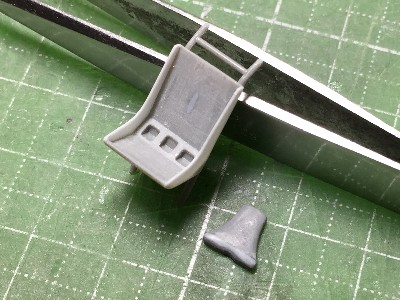
The seat and frame were from the kit. The head pad was from Hasegawa. Plastic sheet was glued on the lower side.
|
|
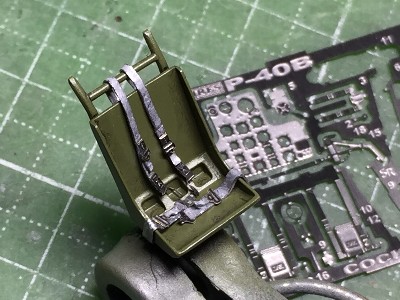
The seat harness was made of lead sheet with Aires photo etch. Well I knew this type of seat harness was not used at AVG aircraft. But, I did not know the details of correct harness.
|
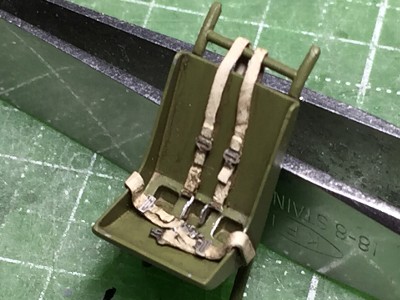
The seat frame was not correct as well. But I used kit parts for the same reason.
|
|
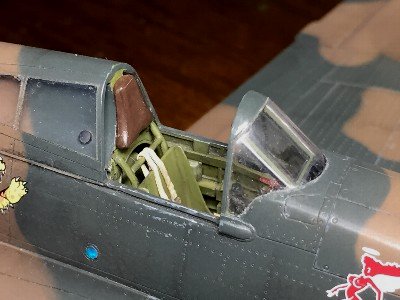
|
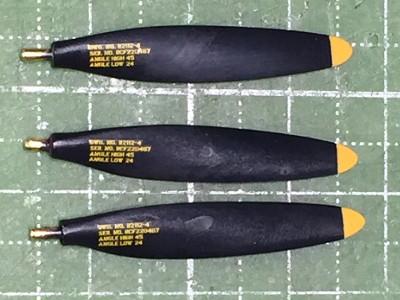
It is unclear that the tip of the propeller blade of #68 aircraft was painted yellow or not. Some photos seems unpainted. But When I finished without yellow, I felt uncomfortable. So I painted yellow.
|
|
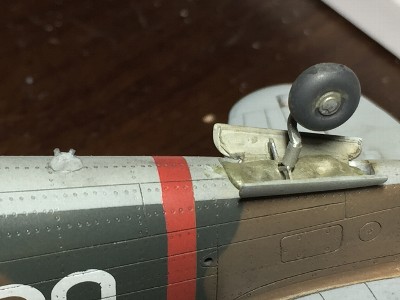
The tail gear and cover were assembled.
|
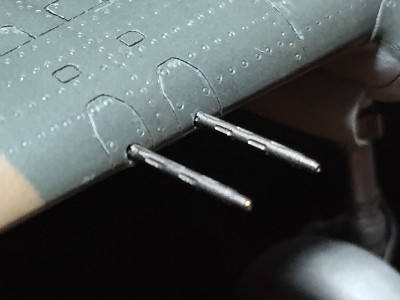
The wing gun was from Master Model.
|
|
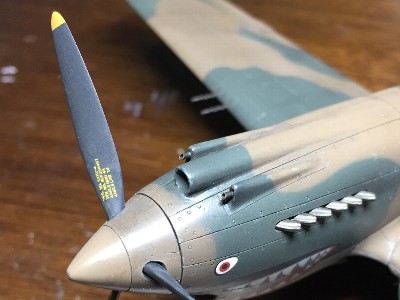
The nose gun tube was 0.8mm brass tube.
|
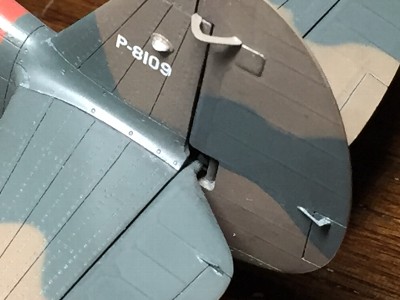
These details parts were made of plastic and glued with thin liquid cement so as not to defede finished surface.
|
|
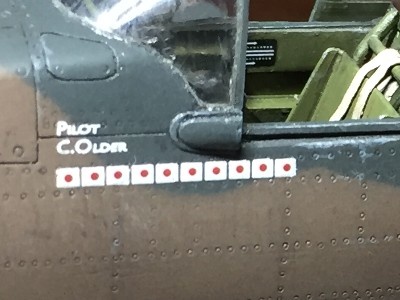
The pilot's name and score marks were dry decals.
|
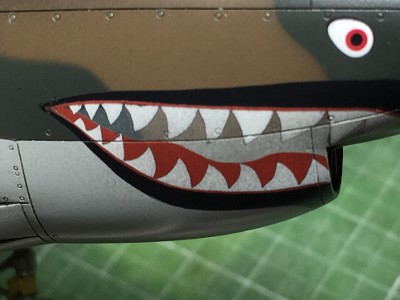
The shark mouth was finished. The inside of the mouth was stained to be a little dark.
|
|
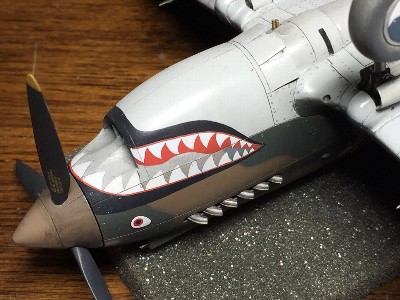
Oh, it looks like a real shark on a fisherman's boat.
|
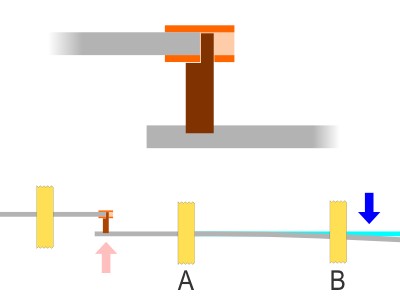
The pitot tube was made of soldered brass. First, tape A was pasted. Then B was pasted. Then the brass parts were tightly fixed.
|
|
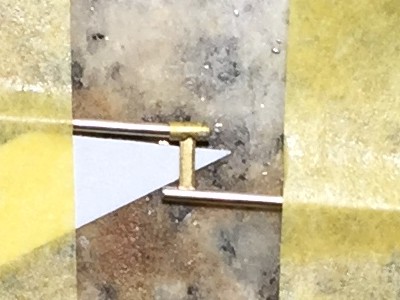
After this photo, each metal parts were soldered. I did not use solder iron but used a pocket gas burner.
|
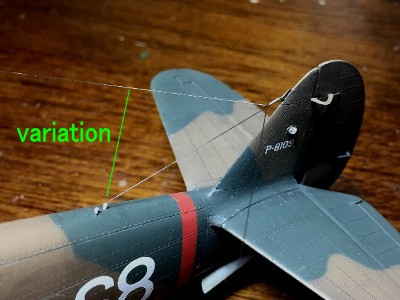
There is a variation shown in green line.
|
|
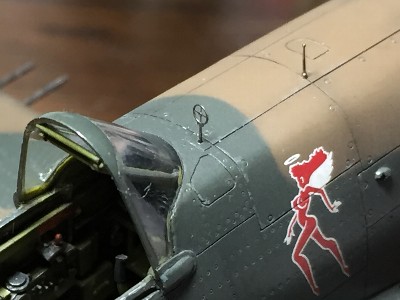
The foresight and ring were from Master Model.
|
Weathering
Exhaust stain and leaking of fuel were depicted with Tamiya color. Light sand and black were airbrushed and then they were partially removed by a brush with Tamiya thinner. The brush was moved up and down.
|
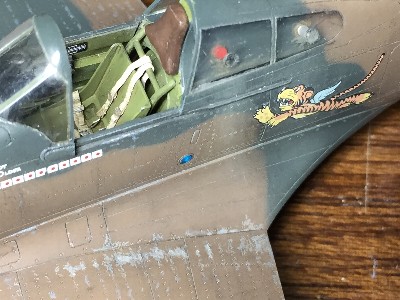
The wing root was chipped with a spatula. Dark earth paint was removed and the silver layer came out. Other chippings were applied medium gray with a fine brush.
|
|
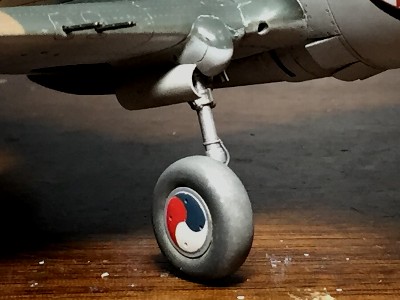
Tamiya color (light sand) was airbrushed and Tamiya weathering master with water was washed.
|
Completion
Finally, my H-81 was finnished. The slide canopy was not glued and movable. I am very satisfied with corrected nose outline with shark mouth. And also I satisfied with the cute and sexy angel. At a late day, the exhaust pipe was 3D printed. It will be replaced at some future date.
|
Illustrations
The first one is H81-A2 serial P-8109 flown by Charles Older, the leader of the 3rd squadron AVG at Kunming China, 1942 early summer.
|
I could not stop to arrange the bust, hip and face of the angel a little from the actual figure and increased the cuteness. Because, I belonged to the comic art club when I was a high school student.
|
To illutrate highlight lines, I made this contour figure.
|
|
|

|
Next illustration is H81 Hawk serial P-8127 is flown by R.T.Smith. Later, he became CO of B-25 Squadron of 1st ACG. There are some photos of different periods of this aircraft. Originally, P-8127 was flown by John Petach of the 2nd Scordon AVG, without angel and tiger, aircraft number was white 47 (same position same font), rear fuselage band and the lip of shark mouth was blue. There is the small white "47" at the nose (near the front of the eyes). A small cartoon of a person who rides a bicycle (sometimes described as a panda) is depicted in the lower part of the right rear window. Next, the lip was black, the fuselage band was red, and the nose number was removed. There are color photos of this state. The next is this illustration. Angels, tigers, pilot names and score marks were added. The wheel cap was in three colors. Starboard side is unknown. I guess with the tiger and angel and without bicycle. The pose of the angel on starboard is unknown.
There is the rear view mirror near the top of the windscreen slightly to the starboard. The aircraft seen in photos is extremely dirty and the boundary between DG and DE is fuzzy, but the illustration is drawn with the original pattern (just shoddy work). However, the over painted vertical stabilizer is unclear, and the illustration is painted as fuzzy. The angel is slightly smaller than # 68 aircraft. The shape of shark mouth and eye, the position of angle and tiger are also differ.
|
|
|
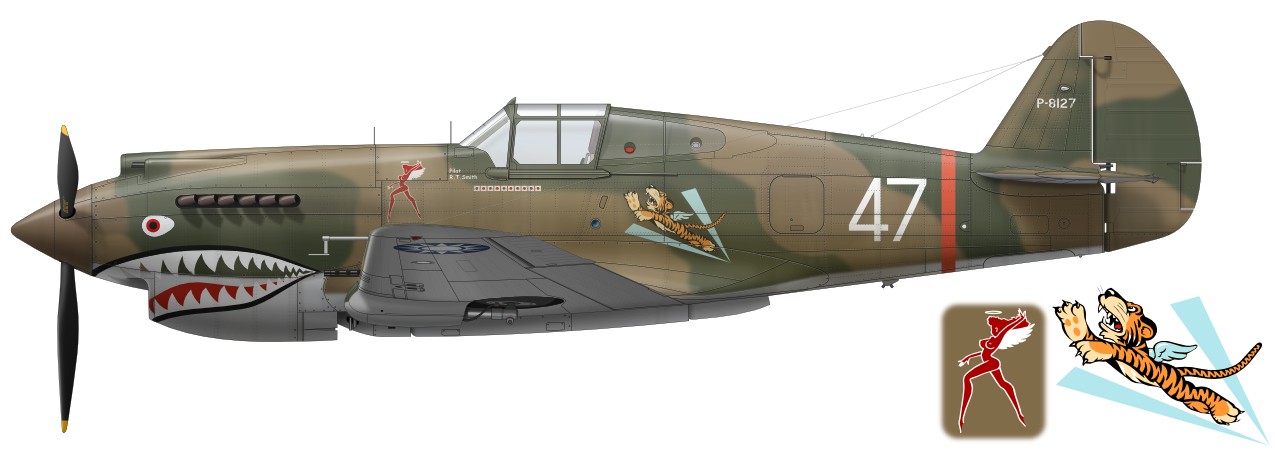
|
The RAF No 112 "Shark" Sukodoron Tomahawk Mk.IIb AK402 GA-F is flown by Plt Off Neville Duke in Egypt, November 1941. There is a photograph from the port rear side in the Osprey RAF Hawk book. There are bright spots on the rudder, but I guess it is a dirty picture. There are some photos of aircraft which have the letter of GA-F, but it is suspicious whether it is the same aircraft or not. Details of the shark mouth are unclear from this photo, but I will refer to another photo from the front,
It is a feature of No 112 Sqn that the letter is thin and squarish. The vertical bar of F is long. The right side may be GA-F guessing from the other aircraft. For the space for GA is tight, the type design is narrowed. The square perimeter of the serial is dark. The underside color is a little bright and the impression of the photo is Azer Blue. Or, it might be slightly whitish light gray of US made approximate color. The RAF Tomahawk features a mast antenna. The antenna wire extends from the wing tip. The crank-shaped pitot tube, GM2 gun sight and port aileron fixed tab are also features.
The No 112 Sqn is opened in 1917 with Sopwith Papp. The nickname of "The Shark Squadron" originates the first unit which paint shark mouth on the P-40. It equipped Gladiator , Hurricane, from July 1941 with Tomahawk and December with Kitty Hawk in North Africa, then converted to Mustang Mk.III in June 1944 during the Italian invasion. I continued to use P-40. After the war, they used vampires, canada sabers and hunters.
Plt Off Neville Duke (at the time of illustration) records 27 shoot down and was Allied top ace in MTO. After the war, he became a test pilot and in 1953, he became a hunter and a top speed world record holder.
|
|
|

|
Next aircraft is P-40K of No 112 squadron GA-L FR 472 at Medenin base, Tunisia in the spring 1943. There are original color photographs . This aircraft is not M model but long-body K model (P-40K-10 or later), because there is no small hole in the cowl. A series of photographs also show GA-V FR440, and the design of the shark mouth and eye are slightly different, and there is a yellow edge on the lower wing roundel, and there is no antenna mast but wires.
From the caption, these two aircraft are the leaders of each flight A and B, Flt Lt E. Saville (SAAF) and Fg Off L. Usher (which one is unknown). The other one in the back is Sqn Ldr G. Garton CO of 112 Sqn, but It can not be read the letters and serials.
Underside color of all three aircraft is pretty dark. Is it dark mediterranean blue, or US made Approximate color. The wheel cap is also a lower color and the edge is silver. The letter seems to be medium sea gray, but it appears bluish in the photograph, and there is a possibility of mixing white with the under color or some local color. The spinner and mouth are dull red. The starboard letter would be L-GA in this case's example. Note that Kitty Hawk's upper wing roundel is marked fairly inward as compared to US Insignia. The size is 45 inches and it is about 42 mm at 1/48 from the wing tip to the center. On the other hand, the lower surface is 32 inches (excluding the yellow edge), and from the wing tip to the center is about 30 mm in 1/48. Also note the yellow strip on the wing leading edge. They are no so dirt, and they seem to be just after delivery.
|
|
|

|
The next illustration is Mohawk IV BJ546 OQ-O, H75-A4 of RAF No 5 Sqn, March 1942, in Akyab, Burma. Boarding a New Zealander Flt Sgt C.V. Garg dispatched from 67 Sqn. Although the camouflage of the rudder of the photo looks irregular, I guess the dirt of the photo. A sheep dog head on the cowl. The color of the spinner is uncertain. Sky or NMF? The aircraft was lost in May of the same year with another pilot. Note the rear view mirror on the windscreen and GM2 gun sights.
The RAF No 5 Sqn was established in 1917 and has been active in the CBI theater from 1920 to 1947. In 1942, it changed from Hawker Hart to Mohawk, and assisted Blenheim bombers in Burma. Then converted to Hurricane, Thunderbolt, Tempest II. After the war, the unit used vampires, venoms, meteors, javelins, lightning, etc. and joined the Gulf War in Tonado F3.
|
|
|

|
P-40L-5-CU 42-10664 "LIGHTHOUSE LOUIE" the 325th FG "Checkertail Clan" CO Lt Col Gordon H. Austin, Tunisia, June 1943. I have been thinking that the letters are not Black but Red. It is definitely red in the color sense of nose arts of those days. Black is too unspectacular. If you look closely at the original photos, the brightness of the letter is higher than the light house roof (it was thought as black). When I built my model, I used Aero Master decals of black. For I thought there was no need to correct at that time. This illustration is the revenge!
|
|
|

|
Two more desert Marlin Hawks. First, P-40F-5-CU 41-14491 of the 58th FS 33rd FG. The pilot name is unknown. Many P-40s were lost in the early stage of the Operation Torch, 35 aircraft of P-40Fs led by Major Cochrane launched from HMS Archer aiming for Tunisia, on November 15, 1942, as an additional force. The ship for Swordfish is small, and even with the compressed air catapult, it is said that the two were submerged in the sea due to lack of speed.
The details of the photo of the aircraft are unclear, and the serial is based on the Osprey MTO Ace book. There are also 41-14512. The size of the stars and stripes beside the fuselage is not so accurate. The fuselage insignia is 35 inches in size (excluding the yellow trim). Tail serial is a thick font often found on MTO P-40. The 59 FS aircraft has a star and stripe flag under the left wing, and I draw it as possibility.
|
|
|

|
Next, short tail F model P-40F-5-CU 41-14281 of the 314th FS 324rh FG 2nd Lt MacArthur Powers, in Egypt, February 1943. A photo of the starboard is in the Osprey MTO Ace book, and the letter is Y2 * 0. He moved to the USAAF after 2.25 shooting down with RAF 145Sqn Spitfire VB. The diamond at the nose is yellow in this Osprey book, but I guess as white from the lightness difference with dessert pink. No confirmation.
The 314th FS was established as a P-40 unit in summer 1942, and moved to Egypt in October, using short tail F and lately long tail F / L with patrol and escort. After landing in Italy, fighter bombing was the main mission, and in July 1944, changed to P-47D, and it fought in Italy until the end of the war.
|
|
|

|
P-40K serial unknown, number 24 THUNDERBIRD II is flown by 1st Lt George R. Barnes of 16th FS 23rd FG at Kunming, early 1943, The 16th FS was established as a P-40 squadron in 1941. In March 1942, it was dispatched to India to protect the Indian side of the Hump (Himalayas) crossing route, and supported the ground forces in northern Burma by sweeping, bombing, reconnaissance, and patrol. It moved to Kunming, China in June 42, and was in charge of the Chinese side of the Hump. The unit equipped with P-51A in 1944 and then P-51D. After the war, P-47, F-80, F-86D, F-102, and F-4 were used, and mainly deployed in the Far East, such as the US homeland, Naha, Misawa, Itaduke, Tsuiki, Taiwan, and Korea. Currently uses F-16 at Naris Air Force Base.
|
|
|
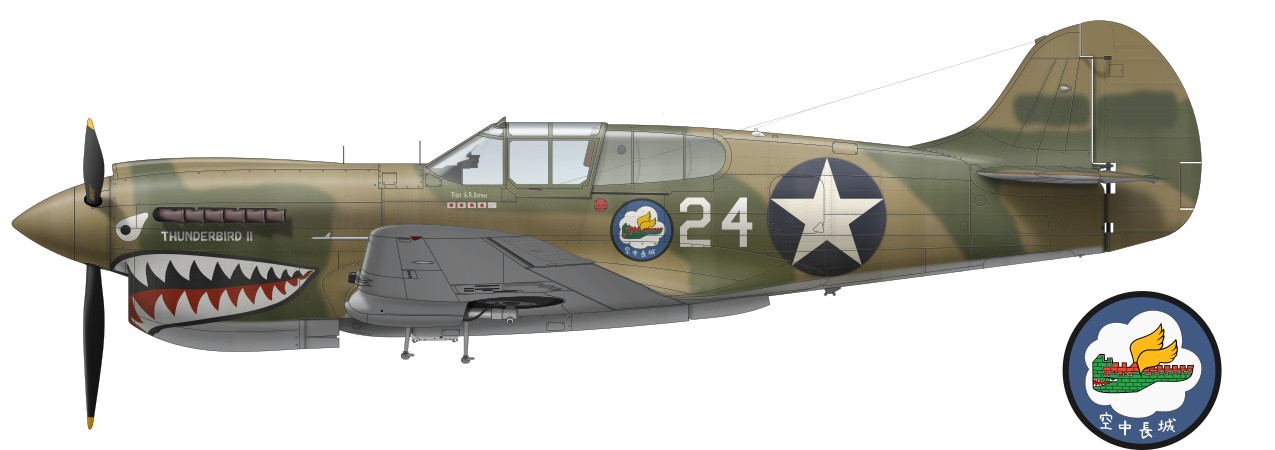
|
Aleutian Tiger P-40E of 11th FS 343rd FG at the Fort Glen base on the Umnak Island in the late 1942 to 1943. Serial and crew are unknown. There is a photo of the whole starboard side. The design of the tiger was referred to this. The details are from other aircraft of the same unit. The face of the tiger is slightly different for each aircraft. P-40s of this unit equipped cold area specification, a gun heating system using exhaust heat. Details of this system vary depending on the aircraft.
There is aircraft number 49 with almost the same painting, and this tiger is a little short in back and forth. The wheel cap is yellow. This camouflage scheme may be olive drab / neutral gray. The right and left tiger faces are not connected at the top. The jaws are connected left and right, and it is difficult to see in the illustration, there are four lower front teeth. The letter "US ARMY" on the lower wing is unclear.
11th FS was opened as a P-40 flight squadron in January 1942 (there is also reference describing as September). Soon after, it moved to the Aleutian Islands, and worked with the 18th FS (P-40), 54th FS (P-38), and 344th FS (P-40) of 343rd FG as air defense, sweeping, and bomber support. The last battle operation was October 1943, but thie unit remained on the same site until the end of the war, and conducted patrolls and reconnaissances. In addition to P-40s, P-38s were used in 1943, and it become all P-38 unit in 1945. After the war, the unit used F-89D, F-102, F-106, etc., mainly for air defense in the Alaska area, and was closed in 1968.
|
|
|

|
P-40N The Kitty Hawk IV of RNZAF No 18 Sqn in New Guinea, Ondonga. There is a photo in RAF Kitty Hawk aces book. If the caption of this book is correct, this aircraft may be in late 1943. The clear vision canopy (after N-5-CU) appeared May 1943. If you look closely at the photo, it seems that an oblique white band (it looks like Ki-43 of IJA 64th Sentai) was painted the top of the wing. Also, there is a possibility of existence of the roundel on the port lower wing. But I guess that it has disappeared. There is a black (about 8 inches) serial (NZ + 4 digits) under the horizontal tail, but the number is unknown. So I omitted it.
No 18 Sqn moved into New Guinea from October 1943. Initially converted to P-40, later to F4U-1. Then the unit moved to the Guadalcanal in November 1944 and conducted air support for the Australian Ground Forces in the Battle of Bougainville Island. End of the year 1945.
|
|
|

|
The last one is P-51D-5-NT Mustang of Lt Col C. Older who belonged to USAF after AVG dissolution. There are photos of the port nose and near the cockpit. Tail marking follows the illustration in Osprey 23rd FG Aces book. However, the antenna pod on the back is not drawn because it is unknown (there is no other case in the same aircraft). The "Yokahama Yardbird" was because his relatives were Japanese prisoners of war. 23rd FG emblem also refers to the same book. The color scheme and details are slightly arranged based on the photos. This aircraft was made in Dallas factory, and the canopy seems to have a unique shape. Anti-glare is black from the color photo, but there is a possibility that this is the usual Olive Drab and the color photo is a colored monochrome one.
|
|
|
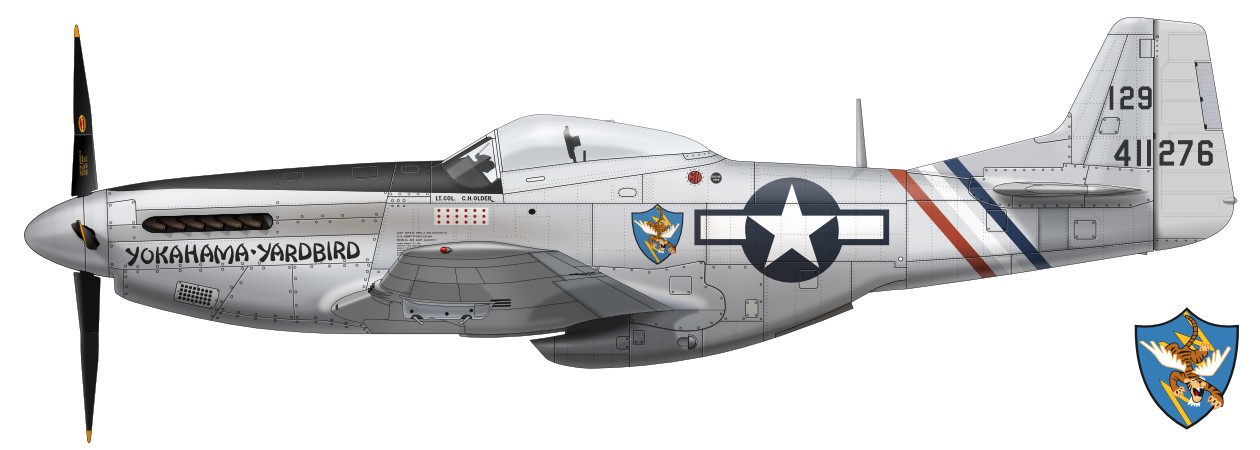
|
Lt Col Charles H. Older was born in 1917 and graduated from the University of California, joined the Marine Corps, where he became a pilot and was assigned to VMF-1. In July 1941, he volunteered for the American Volunteer Group, and joined the third squadron. The unit began operations at north of Rangoon in Burma. Hawk H81 fighters arrived in November and took air difence with Buffalos of RAF 67th Sqn. Rangoon attack by Japanese began on December 23, and in a fierce interception he recorded five shoot down. After that, he moved to Kunming, and became the leader of the third squadron and recorded five more shoots.
AVG was dissolved on July 4, 1942, and he returned to USA and belonged to the Air Force. In the summer of 1944, he returned to the front as Major and deputy commander of 23rd FG which was the successor unit after AVG's dissolution. He recorded eight more shoots with the P-51D. He became the top ace for the USAF of CBI. After the war, he entered the Korean War as the A-26 pilot. He later retired from the Air Force, earned a law degree at university, and later became a member of the legal community, serving as a judge in a famous case. Death in 2006.
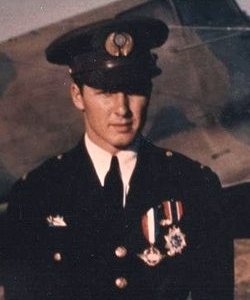
|
Drawing Page
HOME
|
